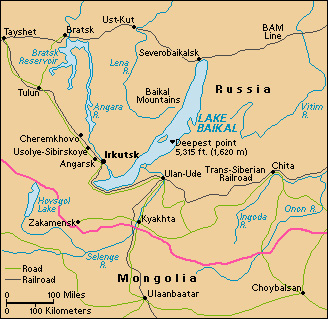Lake Baikal, << by KAHL >>, also spelled Lake Baykal, is the deepest lake in the world. It contains over 20 percent of the world’s unfrozen fresh water—more fresh water than any other lake. Lake Baikal lies in southern Siberia, near Russia’s border with Mongolia. The lake is 5,315 feet (1,620 meters) deep at its deepest point. It covers an area of 12,200 square miles (31,500 square kilometers), measuring about 395 miles (636 kilometers) long and about 49 miles (79 kilometers) wide at its widest point.

Geologists estimate that Lake Baikal formed about 25 million years ago, making it the world’s oldest lake. More than 1,500 kinds of plants and animals live only in Lake Baikal or the nearby area. They include a fish called the golomyanka and the Baikal seal, one of the few seals that live in bodies of fresh water. Several Russian national parks and nature reserves surround the lake. In 1996, the United Nations Educational, Scientific and Cultural Organization (UNESCO) named Lake Baikal a World Heritage Site as an area of unique natural importance.
The large volume of water in Lake Baikal affects the weather in the surrounding area. For example, the area nearest the lake has temperatures several degrees warmer in winter, and cooler in summer, than places farther inland. The lake’s surface is usually frozen from January to May. The Selenga River (spelled Selenge in Mongolia) is the largest of more than 335 rivers that flow into Lake Baikal. Only the Angara River empties out of it.
Mines empty waste into tributaries of the lake. From the 1960’s to 2013, a paper mill on the southern shore generated both water and air pollution. In 2014, the Russian government launched a program to clean up the lake.
